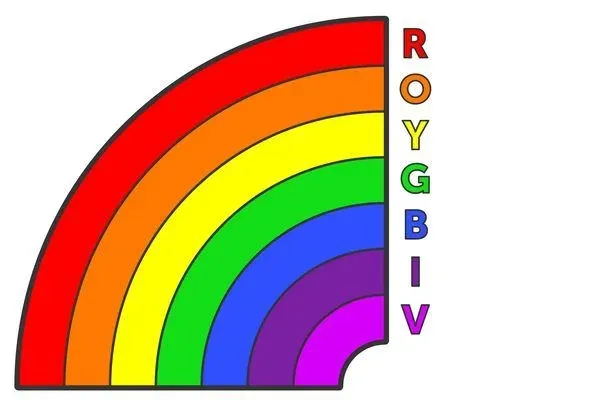Rainbows have captivated human imagination for centuries.
With their vibrant hues painting the sky after rainfall, they are nature's
artistry at its finest. Beyond their aesthetic appeal, rainbows hold profound
symbolism and scientific wonder. Let's delve into the kaleidoscope of colors
that adorn the arc of a rainbow and explore their significance.
The Spectrum of Colors
Rainbows are formed when sunlight refracts, or bends, as it
passes through water droplets in the atmosphere. This refraction causes the
light to separate into its component colors, creating a spectrum that spans
red, orange, yellow, green, blue, indigo, and violet. This sequence of colors
is often remembered by the acronym ROYGBIV.
Each color in the rainbow spectrum carries its own distinct wavelength and energy. From the longer wavelengths of red light to the shorter wavelengths of violet light, each color contributes to the stunning display that graces the sky.
Symbolism and Cultural Significance
Throughout history, rainbows have been imbued with symbolic
meaning across various cultures. In many societies, rainbows are seen as a
bridge between the earthly realm and the divine. They symbolize hope, renewal,
and transformation, often appearing in mythology and folklore as a sign of good
fortune or a connection to the spiritual world.
In addition to their spiritual significance, rainbows have become powerful symbols of diversity and inclusivity in modern times. The rainbow flag, originally created as a symbol of LGBTQ+ pride, has evolved into a widely recognized emblem of equality and acceptance.
Scientific Insights
Beyond their symbolism, rainbows offer valuable insights into
the physics of light and optics. The process of refraction and dispersion that
creates a rainbow is governed by the principles of Snell's Law and the
differing refractive indices of light in water droplets.
Moreover, the presence of rainbows in nature has practical implications. For instance, the study of rainbows can aid in understanding atmospheric phenomena and improving weather forecasting techniques.
Artistic Inspiration
The mesmerizing beauty of rainbows has inspired artists,
poets, and creatives across the ages. From ancient cave paintings to
contemporary works of art, the rainbow's vibrant colors have been a source of
inspiration and fascination.
In the realm of literature, rainbows often feature as symbols of optimism and beauty. Poets and writers frequently use rainbow imagery to evoke themes of hope, promise, and the fleeting nature of beauty.
Conclusion
Rainbows are more than just colorful arcs in the sky; they
are symbols of beauty, diversity, and scientific wonder. From their intricate
formation in the atmosphere to their rich cultural symbolism, rainbows continue
to capture the imagination of people around the world.
As we gaze upon a rainbow stretching across the horizon, let us marvel at the harmonious blend of colors and reflect on the profound meanings they hold. In a world often shrouded in uncertainty, rainbows remind us of the enduring power of light, beauty, and hope.
Frequently Asked Questions About Rainbow Colors
1. What causes a rainbow to form?
Rainbows are formed when sunlight is refracted and dispersed
by water droplets in the atmosphere, typically after rainfall. This refraction
separates sunlight into its component colors, creating the spectrum that we see
as a rainbow.
2. Why do rainbows appear in a specific sequence of colors?
The sequence of colors in a rainbow—red, orange, yellow,
green, blue, indigo, and violet—is a result of the varying wavelengths of
light. Each color corresponds to a specific wavelength, with red having the
longest wavelength and violet the shortest.
3. What is the significance of the acronym ROYGBIV?
ROYGBIV is often used as a mnemonic device to remember the
sequence of colors in a rainbow: Red, Orange, Yellow, Green, Blue, Indigo, and
Violet.
4. Are rainbows always arched?
While the classic rainbow shape is an arc, rainbows can
appear in other forms depending on atmospheric conditions and the observer's
perspective. Double rainbows, supernumerary rainbows, and circular rainbows are
some examples of alternative rainbow shapes.
5. Can rainbows appear at night?
Rainbows are typically formed when sunlight interacts with
water droplets in the atmosphere, so they are most commonly seen during the
daytime. However, under certain conditions, such as the presence of artificial
light sources like streetlights or moonlight, lunar rainbows or moonbows can
occur at night.
6. What cultural significance do rainbows hold?
Rainbows have been revered in various cultures throughout
history, symbolizing concepts such as hope, renewal, and connection to the
divine. In modern times, rainbows have also become symbols of diversity,
inclusivity, and pride, particularly within the LGBTQ+ community.
7. How are rainbows depicted in art and literature?
Artists and writers have long been inspired by the vibrant colors and symbolic significance of rainbows. They frequently appear in paintings, literature, and other forms of artistic expression as symbols of beauty, optimism, and the wonders of nature.
8. Are there scientific applications for studying rainbows?
Studying rainbows provides insights into the physics of
light, optics, and atmospheric phenomena. This knowledge has practical
applications in fields such as meteorology, astronomy, and the design of
optical instruments.
9. What is the significance of the rainbow flag?
The rainbow flag, originally created as a symbol of LGBTQ+
pride, has evolved into a widely recognized emblem of equality, diversity, and
inclusion. It represents the LGBTQ+ community's resilience, visibility, and
ongoing struggle for acceptance and equal rights.
10. Are there any myths or misconceptions about rainbows?
One common misconception is that rainbows only have seven
colors. In reality, the colors in a rainbow form a continuous spectrum, with
overlapping shades between each color band. Additionally, while rainbows are
often associated with rain, they can also be formed by other sources of water
droplets, such as mist or spray.



0 Comments